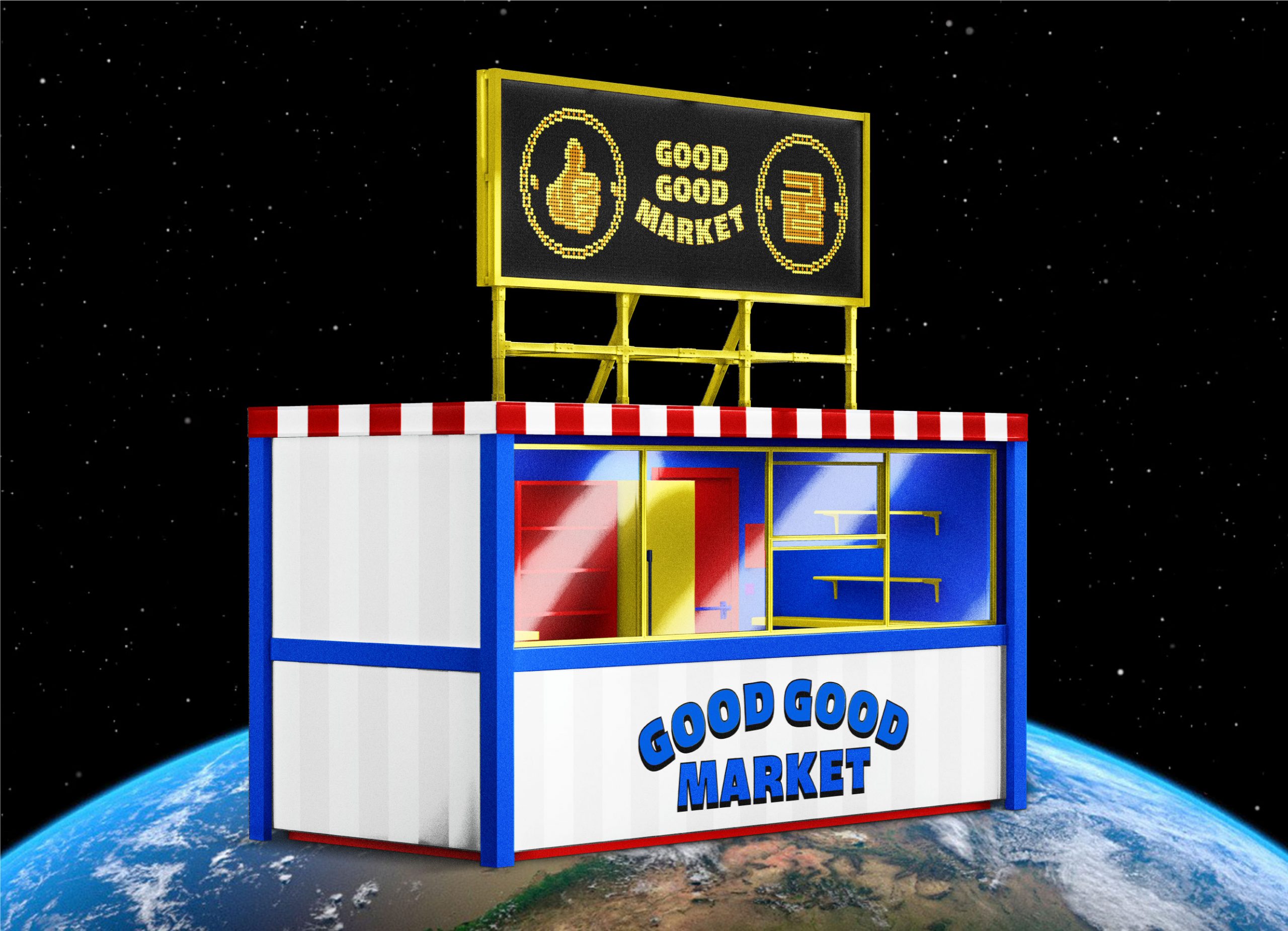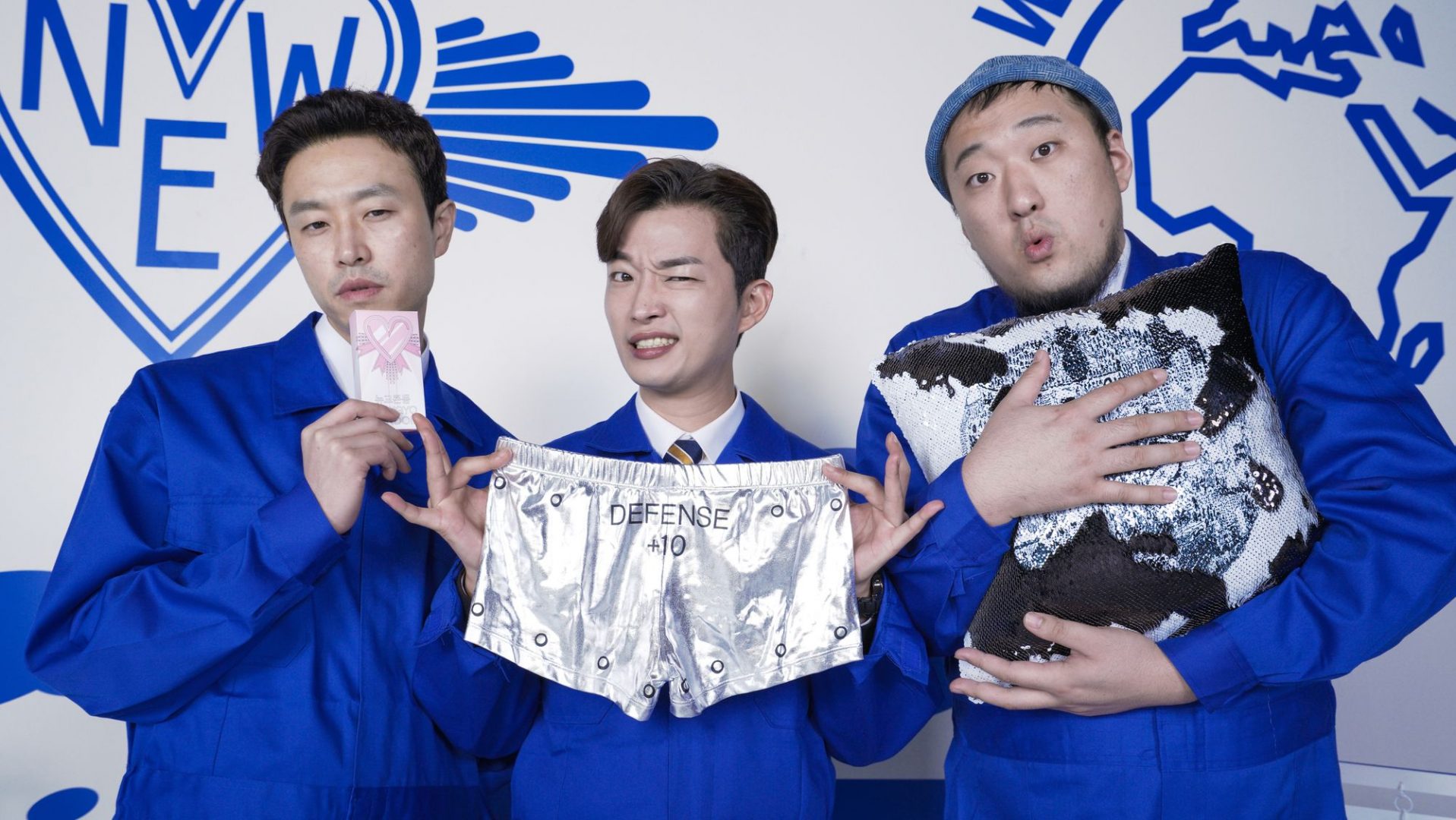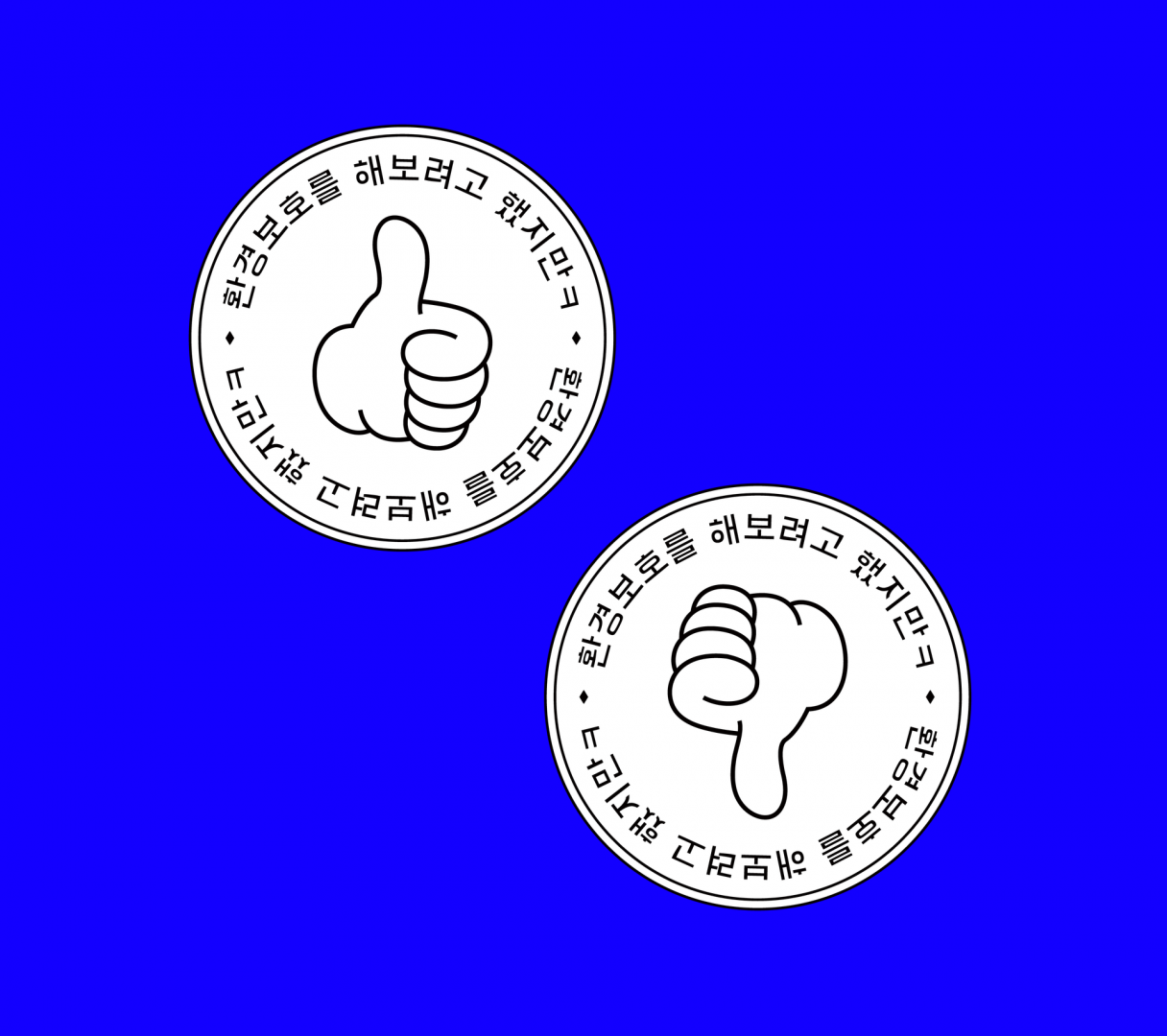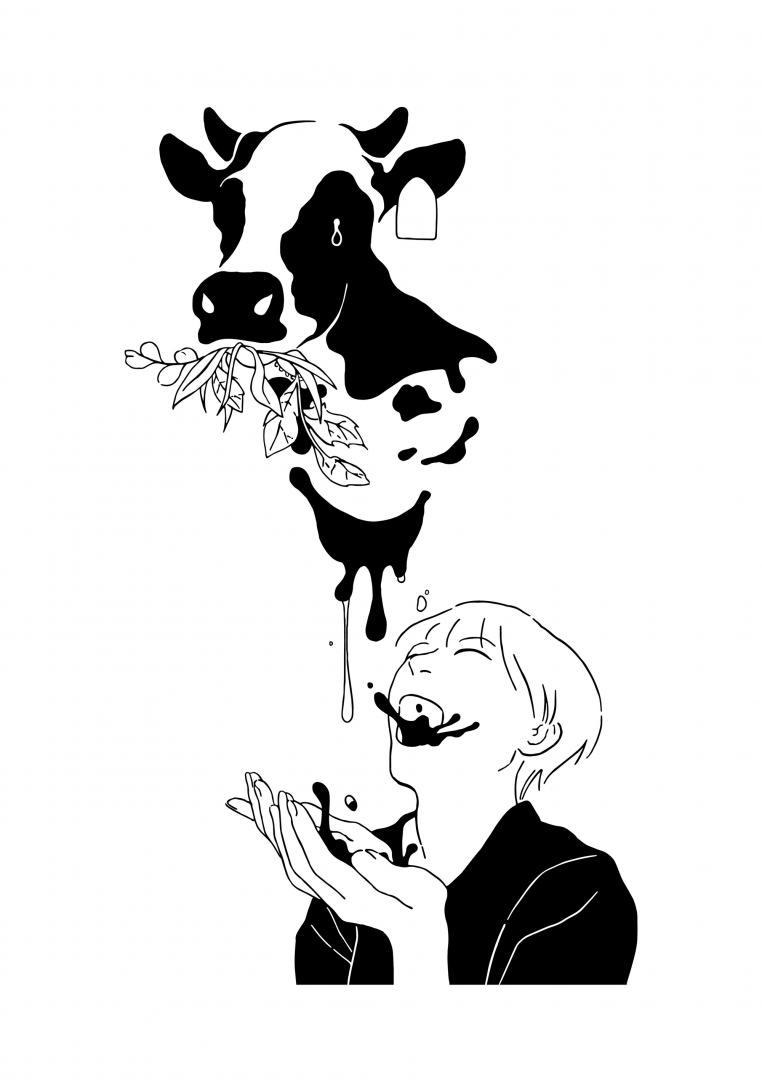
Good Good Market
Exhibition date October 22, 2020
Location Art space Mullae, Seoul↗ / Hwang Kim YouTube Channel↗
Exhibition date Nov 26, 2021 ~ Feb 27, 2022
Location Centre for Heritage, Arts and Textile, Hong Kong↗
Directed by Prof. Hwang Kim
Interviewed by Prof. Dongjin Seo of Kaywon University of Art & Design
The interview below is a discussion on professor Hwang Kim’s recent work titled, ‘Good Good Market’, that was exhibited at the Obscene Festival between October 9 and October 29 in 2020. Here, professor Dongjin Seo of Kaywon University of Art & Design, asks Kim about his intent and artistic choices in this work. This interview was originally prepared for the official publication of the festival, and we publish it here with the permission of both professor Seo and professor Kim.
Dongjin Seo(DJ) Hello. My name is Dongjin Seo and I am teaching at the Intermedia Art Department at Kaywon University of Art & Design. I would like to engage a conversation with Hwang Kim, who is preparing for a performance titled Good Good Market at the upcoming OP/SCENE festival. First of all, may I ask you for a brief introduction?
Hwang Kim(HK) I am Hwang Kim, a designer and interdisciplinary artist. I’m working on a new work Good Good Market to present at the OP/SCENE Festival for the first time in six years.
DJ Firstly, could you briefly introduce the overview of Good Good Market?
HK Good Good Market deals with the theme of the dilemma arising from the gap between value and capital and it takes the form of ‘Labang,’ which is a term for a streamed live broadcast.
DJ ‘Labang’ is a rather unfamiliar word for me. Please explain briefly.

HK It is a new genre in sales that is called ‘media commerce.’ Show hosts use YouTube or other online platforms to sell specific products. It would be easy to understand to think that TV home shopping is operating inside the Internet. It is more advanced content commerce in terms of its structure.
Recently, the controversy over undisclosed advertisements by creators has become apparent. Whether it is through undisclosed advertisements happening behind the scene or the opposite, creators sell products through their own video narratives and platforms serve as the bridge between creators and consumers. It is an arena of advanced consumerism where the three elements work together: platforms, video content created directly by the general public, and consumption not based on need but on impulse. China was the first to promote this ‘genre’ by giving birth to the so-called ‘Wanghong economy.’ We can consider that the segmental structure, a characteristic of modern capitalism, has been fully developed within the domain of commerce.
DJ I thought that one of the stories told by Good Good Market is about the metamorphosis of products today. For example, consumption of ethical values of products or certain psychological values, rather than satisfying our physiological needs or resolving certain needs, has become another aspect of consumption.
In particular, you seem to notice changes such as the great attention being paid to products emphasizing social values. This is an important aspect of consumption culture and probably represents aspects of how capitalism works. What motivated you to develop this question in mind?
HK I majored in design and I still call myself a designer indeed. Design as an academic discipline emerged with the Industrial Revolution-Modernism. Design put much effort into drawing a line with pre-modern activities that ‘resembled’ it (such as crafts). As such, design and modernism in fact make one body that is inseparable.
However, if you look at the manifestation of design, it was not just a field of academic studies to establish a formative language nor an industrial methodology (as was the case with modernism, of course) but a radical spirit of the times. Designer at the time indeed wanted to change the rapidly changing society for the better, and they thought they had that role with a sense of duty. But if you now look at the status of design after hundred years (2019 was the 100th anniversary of the Bauhaus), that spirit is nowhere to be seen. We are facing a design that is only left with a skin, which is called the ‘international style.’
Paul Greenhalgh wrote in Modernism in Design (1990), “the undoubted crimes of the International Style should remind us how easily a style can be divorced from the motive forces which invented it and be attached to heinous causes.”
A few designers have sensed this dilemma early on, and they had the critical awareness to diametrically improve the given situation. Initially started with concerns in style and design, the critical awareness penetrates the critique on materiality and eventually leads to the issue of consumerism or capitalism, the source of problems in our time. Resistance to contemporary capitalism and consumerism is occurring simultaneously in many different fields, but such resistance by designers has a strong character of self-denialism that has to deny the manifestation of design as an academic discipline itself.
Through Good Good Market, I perform a bit of satire, objects under certain plans, crowdfunding, and live broadcasting selling objects, which is in other words to organize a project to cast cynicism by borrowing the structure of consumerism.

DJ Your work is called ‘critical design.’ From designers who do radical design or social design, I can glimpse the innate sense of original sin. It is a sense of guilt that we are subject to consumerism no matter how hard we try to do anything.
Similarly, can we consider your critical design practice as a self-repulsion or objection to your identity as a subject of consumer capitalism? Then, is your performance or interdisciplinary artistic activity as an act of critical design a self-denialist gesture of your identity as a product designer, or is it an extension of your practice as a designer?
HK I think it’s both. The fundamental performativity of design is difficult to desynchronize from value production. The act of design must produce capitalist value or use value at least. The proposition that ‘form follows function,’ which is still central to modern design theory, still holds true.
However, in the current global crisis, resistance to continuous value production leads to the denial of design practice. If so, the practical design practice in everyday life is to be accompanied by contradictions and pain. There arises a will to overcome contradictions on one’s own, and the act of breaking free from the contradictions is eventually forced to be done again through design, which amplifies the very contradictions.
For example, a design process to solve a waste problem may produce more waste. We may fall into a total paradox of not knowing whether we are going backward or forward while we try to overcome certain problems. But I think we are at a point where we cannot stop either. I am working and making my living while repeating the process of escaping and re-escaping from within such a cycle, that is, by strengthening my will, recognizing the impossibility, and giving up.

DJ One of many important design methodologies that are emerging in recent years is the design based on user or consumer experience is In that sense, most designs today have a performative character to some degree.
Designs are not made on the basis of the psychological needs or physiological satisfaction of users; they are moving towards research-based design or UX design based on the lifestyles of users.
If I were to ask a slightly annoying question, wouldn’t it be possible to think of your work as something that borrows the performative design elements that are in fashion nowadays and wears a hat that is called interdisciplinary art? What is the difference between the performative nature of commercial design practice and your performative practice as an interdisciplinary artist?
HK As you mentioned, with the emergence of new media that connects the Internet-PC-smartphone, the value of digital services is becoming higher than that of the product itself. And the rise of user experience-based design has become apparent. It has become more important to build an ecosystem than the design of the product itself. Branding and storytelling have become more important as well… We can really say that design has become content and that it has become performance.
However, the performatization of commercial design is fundamentally different from the design, choreography, and performance that I exercise as an alternative practice. First of all, commercial design performance is deeply connected with capital, and it is permeated with contempt against humanity.
Ellen Ullman wrote in Life in Code that the user interfaces are “not really your friends. Underlying every user-friendly interface is a terrific human contempt.”
Commercial experience design makes the user experience pleasant, but it unifies different experiences into a monotonous uniformity at the same time. There is a premise that even the minute user experiences are to be controlled using the ‘empathy method.’ The scary thing is: it actually works.
You may have heard of Amazon’s shopping UX. The online and mobile shopping experiences have become very pleasant. It has become incredibly sleek, compared to the past. It takes less than a minute to select a product and pay for the purchase. We refer to such online and mobile shopping experiences as the “Amazon shopping experience.”
This overwhelming experience is made possible by the infinite A/B testing. Through endless and repeated testing, we have created the most perfect online/mobile shopping experience. Those who started later started A/B testing later, which made them incapable of creating better algorithms than that of Amazon. And that is why most online shopping platforms use the same protocol.
It turns out that the same experiential design can be applied across cultures and races on the level of the entire humanity. It is the same with Apple. When Apple designs its minimalist iPhone, which shines like a symbol of modernism, it produces and compares over ten thousand prototypes with a difference of 0.1 millimeters to find the perfect R-value that fits the hands of an animal species called humans. Diversity is out of discussion there. It’s a law that should be applied to all humans. Under such a phenomenon, design clearly acknowledges the failure of postmodernism and returns to the modernist ‘style.’
On the contrary, the design I practice as an alternative performance is based on the non-physical design that escapes from the existing concept of design. In fact, physicality in design is a fundamental element that is difficult to escape from, and it was inevitable to escape from it in order to find an alternative, and I use performance on that very point.
For example, the Bauhaus school taught dance, among others. The theme of a thesis that I want to work on in the coming years for a while is to look into the long-standing relationship between design and performance, coming up with implications with multiple layers.

DJ Going back to the discussion on your work, we can see that the incredible sales activities by show hosts and sellers through ‘Labang’ as a kind of performance. You mentioned earlier that you would cynically imitate it, but I’m curious about your attitude when you bring their performance into your work. Do you want to create an alienation effect through the inconsistency that occurs when you literally imitate their performance or do you want to criticize it directly and create a performance in a new, alternative form?
HK It seems that art to escape from reality is deprived of value and returns to reality through continuous reappropriation. Just as design is left with the notion of style that is just its skin, value does not remain intact by consumerism and capital. Art and reality continue to escape from and are bound by the idling of the situation. I want to talk about that through Good Good Market as well. By selling products to the viewers through the actual broadcasting, it becomes a performance that borrows the format of live sales broadcast and a live sales broadcast that borrows the format of performance. It is important that such ambiguity works on both sides. It is about the escape and reescape, appropriation and reappropriation, and standing between the openings and gaps between them.
DJ Right. It seems that we need a sense of difference between the two if we are to enable the appropriation between the performance in everyday practice and the performance in critical artistic practices. Otherwise, performance is prone to becoming duplication than critical imitation. Next, I would like to ask a question about crowdfunding. The change of identity of being both a consumer and an investor is an important aspect of today’s consumption culture. How did you come to borrow such a format?
HK Crowdfunding platforms have beneficial functions, but they also have risky aspects. Many goods that are sold on crowdfunding platforms are promoting themselves through value-based marketing. The goods that ‘sell value’ create the illusion that consumers have contributed to the solution of certain issues by purchasing them, regardless of the actual resolution of the issues.
Such an illusion ultimately undermines the power to solve problems and delays the actual resolution. It ends up being self-consolation to think that “I did good through this consumption.” Consumption basically provides pleasure, but people in our time are aware of the negative environmental/social impact of consumption whenever they consume. In other words, we feel pleasure and guilt at the same time when we consume.
However, when consuming goods on crowdfunding platforms, the values overlaid on goods remove that guilt. Through certain ‘devices’ such as donating a portion of the profit, consumers can cover up their guilt with self-consolation that they are doing the right thing. Keywords such as sustainability and fair trade tell them that they are spending for the benefit of the good. Good Good Market deliberately produces goods (objects) overlaid with such values, conducts crowdfunding, and sells them through ‘Labang.’

DJ I think that there is also a trend towards dematerialization of commodities today. For example, when Nike first appeared in the market, they made their consumers consume the spirit of “Just Do It” instead of selling them their sneakers. Starbucks makes its consumers drink the ethical value of fair trade, not just coffee.
However, you said that you were drawn to interdisciplinary art and performance where you could operate with certain dematerialized values, ideas, and aesthetic ideals since design is so trapped within materials.
I wondered if the opposite was the case. As commodities are becoming increasingly dematerialized today, we might seem to consume a physical entity called coffee, but aren’t we in fact consuming its ethical value? Such materiality and immateriality, materialization and dematerialization are a few of the important keywords surrounding the issue performance, and I wonder where you are positioning yourself.
HK It is clear that those examples that you just mentioned are happening in abundance, but I think that the ‘product’ still stands at the peak of such happenings. There exists the immaterial image of Nike’s slogan, “Just Do It,” but it is the shoes that bring Nike real money. Of course, Nike came to possess an immense immaterial value thanks to its branding, performance, and storytelling. But what happens when it is deprived of shoes, the commodity?
There still exist tactile objects at the very bottom of the pyramid, and I feel that the material products are holding up the pyramid that is built over the sand. If you ask if commodities are being dematerialized in everyday life, I rather think that the material has been strengthened just like diamonds are created through pressure. In that sense, there is a difference between the volatility of performance as an alternative practice and performance in commercial design.
DJ Thank you for your thoughts. I have always thought that keen observation and critical awareness of performances in everyday life are important for performance artists. With such an idea, I hope that your background as an industrial designer might bear completely different possibilities from other interdisciplinary artists who developed themselves within the field of performance art and you might be able to make a breakthrough from the self-content aestheticism of performance art from the outside through a keen sense of performances in everyday life.